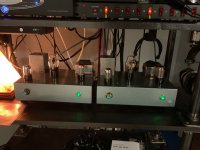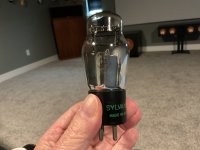atmasphere
Active member
I agree with this. Any zero feedback tube amp has to be very carefully matched to the speaker. If its any good, it will show off the strengths and weaknesses of whatever lies upstream. Just restating what you said...A good SET is not lush , dark etc , as a matter of fact really good top amps have alot of similarity in their sound reproduction which is , they become very pre amp related in what you hear once you match amp drive to load !
ASR had a poll a year or two ago wherein sound files could be downloaded; a set of several songs where you could compare A vs B; B was a wire, A was a chi-fi SET (don't remember what power tube) that cost about $1000.00 IIRC.
Most of the people responding could not tell them apart. I imagine a lot of that was simply because they were doing the comparison on their desktop system... but the point was made
Adding to my prior comment, the big weakness of SETs and SEPs is making bass, due to the requirement of a gapped output transformer. The gap is required to prevent excess distortion due to DC magnetization of the transformer core (this doesn't happen in push pull amps since the two power tubes conduct against each other, cancelling out the DC component). The gap causes a loss of inductance at low frequencies, which causes the load impedance to decrease.
This makes designing a good SET output transformer a challenge!
This characteristic is hard on the tube (causes it to run hotter as power it makes that should be dissipated in the load is dissipated in the tube instead) as the lower the frequency, the more the transformer load impedance decreases. But it gets worse; the load line also gets severely elliptical. This, in addition to the reduced load impedance, cause the tube to make a lot of distortion as well as less power.
Parafeed SETs are an attempt to get around this problem. That requires a coupling cap in addition to the output transformer as well as a pretty big choke to act as a plate load for the power tube. So in solving one problem others are introduced.
These days the way transformer producers try to get around this problem is to make the transformer a lot bigger, able to handle more power. This limits high frequency bandwidth if you get too big. The best transformers I've seen have been rated about 35 Watts but intended for use with a single 300b so it will only see about 7-8 Watt at full power. By doing this you extend the bass bandwidth but the limitations are unavoidable.
So if you want the most out of any single-ended tube amp, its a good idea to cross it over and have some other amp handle the bass. This results in an immediate sense of clarity the amp couldn't do before and of course allow for more usable power since most of the power in music is in the bass region. This is easily done since all that's needed is a small capacitor placed in series with the input. Its also possible to simply use a smaller capacitor at the output of the Voltage amplifier circuit in the amp. Smaller coupling caps tend to have less problems than larger values, so this can result in greater transparency as well.


